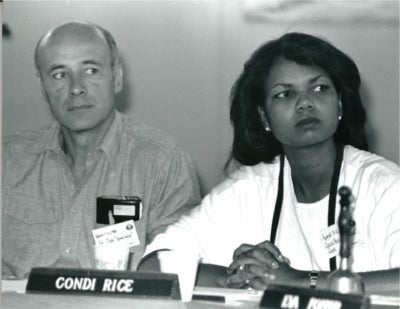The Origins and Culture of the Aspen Strategy Group
By Joseph S. Nye, Jr.
In the early 1980s, American attitudes on foreign policy and strategy were sharply polarized. Soviet aggressiveness following their invasion of Afghanistan in December 1979, combined with President Ronald Reagan’s bellicose rhetoric heightened fears of nuclear war, and launched the Nuclear Freeze Movement which brought millions of people into the streets in the U.S., as well as strong anti-nuclear protests in Europe. The era of bipartisan agreement on détente and arms control was over. Serious experts estimated that the probability of nuclear war was increasing. In August 1983, 61 percent of participants in the Aspen Arms Control Consortium (meeting that year in Baca) estimated the odds of a U.S.-Soviet nuclear war by the end of century as one in fifty. That was uncomfortably high.
In those circumstances, the Ford and Rockefeller Foundations announced they would no longer finance the inter-university consortium on arms control that had been established in the 1970s by my colleague Paul Doty, a distinguished Harvard biochemist and long-time Pugwash participant. On August 12, 1983, Doty and Joseph Slater, president of the Aspen Institute asked me to try to rescue the program. Ford said it was not interested in continuing support, but Ed Deagle, the program officer for Rockefeller indicated that they might consider support if the group became less academic, more bipartisan in composition, and more policy oriented. He cited the Group of 30 in international finance as an example.
Deagle, Doty, and I discussed how to construct such a group and agreed that a key to success would be to select co-chairmen who had partisan identities but were highly respected “across” the aisle. We were fortunate that Brent Scowcroft, former National Security Advisor in the Ford administration and William Perry, former Under-Secretary of Defense in the Carter administration accepted our invitation and agreed to serve. It was also important to pick congressional members who had similar reputations and to avoid the partisan “bomb-throwers” of Washington politics. Again, we were fortunate that our first congressional members were Les Aspin and Dick Cheney from the House and John Warner from the Senate. Over the years, they have had many similar and worthy successors.
The Aspen Strategy Group first met in the second week of August 1984 with a bipartisan group of participants we selected from think tanks, universities, companies, and former officials. Many went on to serve in policy positions in both Republican and Democratic administrations. One was an able young expert on the Soviet Union named Condi Rice who later became Secretary of State and eventually the Republican co-chair of our Group. I served as executive director. I gave up that position when I entered the Clinton administration in 1993, but eventually returned as co-chair. In the interim, the group was fortunate to be led by members like Sam Nunn, Bobby Inman, Ken Dam, John Deutch, Jan Lodal, Robert Zoellick, Philip Zelikow, Kurt Campbell, and many others who served before and after in important policy positions.

The 1984 agenda was dominated by questions of nuclear stability including the vulnerability of Minuteman missile silos, whether to build the MX missile, and the prospects for a Strategic Defense Initiative (SDI). General James Abramson, director of the program, ably presented the case for SDI which the president hoped could be built in seven years. Many members from both parties were skeptical, but they treated the arguments with respect. The same was true the following year when we focused on space, anti-satellite weapons, and the future of deterrence, and in 1986 when we included chemical warfare. Over the years, the agenda broadened further to include the Middle East, the Gulf War, Japan, China, South Asia, the future of NATO, cyber threats, and many other topics of strategic significance.
On many of these topics, members differed sharply over both facts and policy, particularly the Iraq War. But on all, the debates were marked by civility and listening. In some cases, members announced that they had changed their mind, and I regarded that as a hallmark of success. In one case I remember, a high official said he had changed his mind on SDI. In another, a top official responsible for policy in Afghanistan said he had learned more from our week of discussion than from all his Pentagon briefings. While we published an annual report or book about our meetings and held press briefings (sometimes in Senate office rooms), to my mind having key policy people listen and take arguments seriously away from the hubbub and 30 second sound bites of Washington was our most important product.
We contributed to this atmosphere by keep meetings informal, allowing ample down time, and including delicious dinners and lunches. Brent Scowcroft often led hikes to Independence Lake (12,000 feet) or Thomas Lake (in the bowl of Mount Sopris) which were affectionately known as “Brent’s death marches.” I tagged along with my fly rod and occasionally offered fly fishing lessons to those inclined. In the early days, we often organized raft trips on the Roaring Fork or Colorado rivers. You can’t appreciate the West unless you have seen Dick Cheney and John Warner each captaining a raft full of ASG members through the rapids of the Colorado. More seriously, it is hard to hate the other party when you have such shared experiences.
Over its four decades, the Aspen Strategy Group has broadened the age composition of its membership and diversity of topics, the length of meetings, and inclusion of more members of the press who follow the Chatham House rule of using information, but not naming the source without permission. This has helped to broaden one of our deficiencies – direct outreach to a broader audience. But perhaps most remarkable, over that period, the Aspen Strategy Group has managed to develop and maintain an all too rare culture of bipartisan listening. Long may it flourish!

